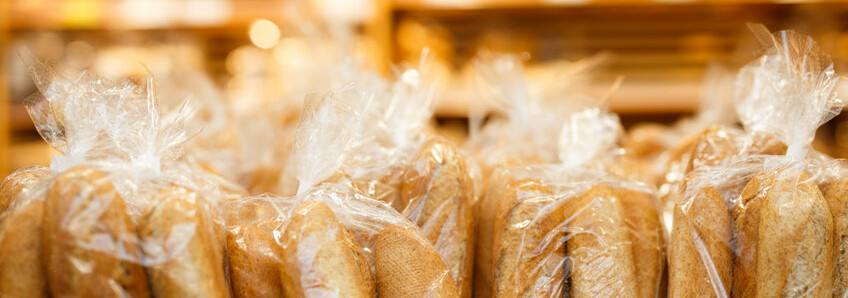
By some estimates, anywhere from a quarter to a third of all food produced globally and destined for human consumption goes to waste. When looking at total weight, bread and many other yeast-leavened goods top the list of avoidable food waste.
Food that goes unconsumed and relegated to the bin may be discarded for various reasons, including:
- Industrial food waste (goods generated at high-speed bakeries)
- Household waste (food purchased but not consumed)
- Food waste occurring at storage and distribution (retailing spoilage)
- Food not sold or consumed within its shelf-life
- Biological contamination of food (moldy bread)
- Stale, dry bread which was improperly formulated and baked and therefore not suitable for commercial sale
Ingredient and Process Optimization: Recipe for Reducing Food Waste
Not only is food being thrown away, but the demand on essential commodities such as cane sugar and wheat—vital ingredients in the production of baked goods and many other staple foods—is higher than ever due to a growing global population. More people means more food production. Doing that as sustainably as possible involves maximizing ingredient use to ensure output is robust while minimizing key ingredient waste. Shelf-life is optimized for longer lasting products, and production yield is as high as possible.
Fundamentally, if sustainable baked goods production is embraced at the industrial level, significant product waste could be avoided. In the baked goods setting, implementation of some or all of the below can help build a more resilient and balanced approach to unnecessary food disposal.
- Enzyme technology at formulation level
- Clean label food preservatives
- Packaging technology which replaces traditional bagging or wrapping procedures
- Baking technologies such as thermal profiling tools
Enzyme Technology
Enzyme technology for shelf-life extension includes maltogenic amylase, fiber-degrading hydrolases and xylanases. Amylases help reduce the size of amylase and amylopectin, hence reducing staling rate. Xylanases and fiber-degrading enzymes transform food polymers into highly-functional hydrocolloids, which tend to bind water and maintain a fresh and moist crumb after baking.
Clean Label Preservatives
Clean label food preservatives that provide both crumb and surface protection against mold growth include organic acids, vinegar, cultured starch, and active compounds from herbs and spices. Different combinations of these ingredients can be used to enhance overall shelf-life and reducing food waste. World-class plant cleaning and sanitation programs for food-contact surfaces and equipment are necessary to increase the effectiveness of clean label mold inhibitors.
Packaging Technology
A packaging technology which offers superior protection of products from external agents like air, moisture, and airborne mold / bacteria, is paramount for a long and reliable shelf life. Bagging and/or wrapping technologies will soon be replaced by total sealing technologies, thicker and multilayer polymer films which resemble those used for the snack industry.
Thermal Profiling
In addition to the above shelf-life extension strategies, a process-focused tool that can help bakers with reducing food waste by baking their products in an efficient and sustainable way involves thermal profiling. This is the measurement, recording and analysis of time and temperature data obtained from sensors at product (dough or batter) and oven air level.
Thermal profiling enables bakers to obtain actionable data about oven conditions. During baking, the product expands to its final volume, loses weight in the form of water, and transitions from dough to crumb – a key physicochemical change for finished product texture. Additionally, heat conferred during the baking process ensures the elimination of mold spores and pathogenic microorganisms that can compromise food safety and product preservation.
Baking is a balance, neither over-baking or under-baking are desirable. Extracting too much water from the dough (over-baking) sacrifices precious scaling weight at the divider and may result in a super-dry product that stales quickly. Conversely, under-baking a product is also less than ideal. An overly moist and gummy crumb which lacks structure and collapses upon storage could result. Plus, customer complaints about moldy bread are something to avoid!
Actionable data obtained via thermal profiling boosts bakery profitability while protecting the plant-based food supply from needless waste. Oven adjustments lead to optimum bake-out which reduces energy consumption while improving production capacity with a no-scrap yield.
Thermal events during baking and how they help reduce food waste at bakery level
| Thermal Event | Commercial Pan bread | |
| Internal Temperature (°C / °F) | Target % Total Bake time | |
| Yeast Kill | 56 / 132.8 | 50 |
| Arrival to final, constant temp. | 93 / 200 | 82 – 85 |
* Values for low altitude baking (0 feet above sea level)
The higher the arrival value (i.e., the longer it takes for the dough to heat up during baking), the:
- Higher the moisture of the product, which then can produce the following:
- Higher moisture content usually implies higher water activity (aw)
- Increased aw means higher chances for mold growth
- Clean label bread, formulated without calcium propionate and/or sorbic acid, will be more prone to post-oven contamination
The lower the arrival value, the:
- Higher the amount of crumb softening enzyme that’s needed, usually maltogenic amylase, to maintain crumb texture-microbial shelf-life balance
- Lower the bake time needed to obtain an equivalent proper texture and water removal
- Lower the chances for mold growth, but a higher likelihood that bread will stale faster
Thermal profiling is one of the most effective and simple methods available to balance oven conditions and obtain solid data about product conditions in-process. Leveraging thermal profiling to increase yields and produce high-quality output ensures that ingredient use is maximized, shelf-life projections are met and, ultimately, unnecessary food waste is reduced.

